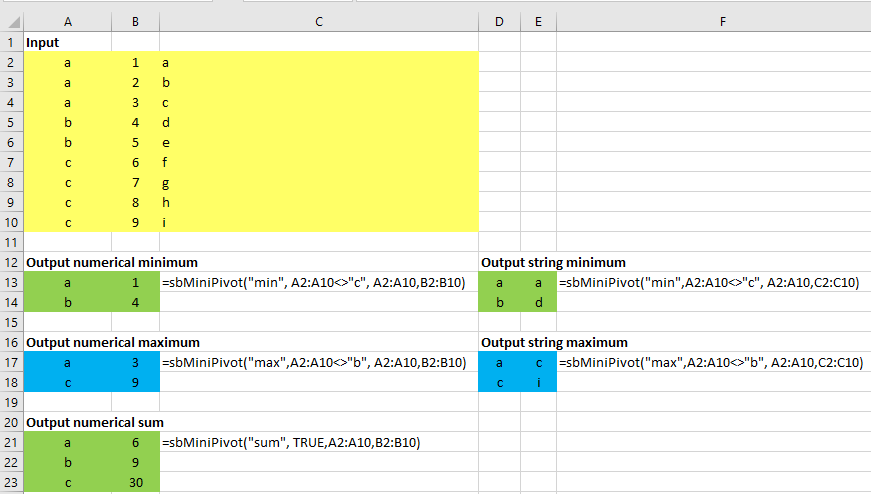“It’s not what you look at that matters, it’s what you see.” [Henry David Thoreau]
Note: Please notice that Excel 365 Insider now offers two similar but more powerful worksheet functions than sbMiniPivot - GROUPBY and PIVOTBY. Once your Excel can use these functions, my UDF sbMiniPivot should only be used for VBA training purposes.
Abstract
If you want to apply a function like CAT, COUNT, MAX, MIN or SUM on a list of given number or string combinations with a condition applied, you can use sbMiniPivot.

Name
sbMiniPivot - Concatenate, count, sum or return min or max of last given input column for all combinations of the previous ones where same row of condition column is True
Synopsis
sbMiniPivot(sFunction, vCondition, ParamArray vInput)
Description
sbMiniPivot performs the function sFunction on last given column of vInput for all combinations of the previous ones where corresponding elements of vCondition are True. It returns a variant array.
Options
sFunction - Specifies the function which has to be applied to the combinations. Can be concatenate (cat), count, max(imum), min(imum), sum
vCondition - Condition constant True or False or column which needs to contain True/False values
vInput - Two or more columns. sFunction will be applied on last input column for all combinations of the previous ones where same row of condition column is True
Appendix – sbMiniPivot Code
Please read my Disclaimer.
Option Explicit
Enum mc_Macro_Categories
mcFinancial = 1
mcDate_and_Time
mcMath_and_Trig
mcStatistical
mcLookup_and_Reference
mcDatabase
mcText
mcLogical
mcInformation
mcCommands
mcCustomizing
mcMacro_Control
mcDDE_External
mcUser_Defined
mcFirst_custom_category
mcSecond_custom_category 'and so on
End Enum 'mc_Macro_Categories
Function sbMiniPivot(sFunction As String, _
vCondition As Variant, _
ParamArray vInput() As Variant) As Variant
'sbMiniPivot performs the function sFunction on last given column of
'vInput() for all combinations of the previous ones where corresponding
'elements of vCondition are TRUE.
'Example:
' A B C
' 1 Smith Adam 1
' 2 Myer Ben 3
' 3 Smith Ben 2
' 4 Smith Adam 7
' 5 Myer Ben 4
'Now array-enter into D1
'=sbMiniPivot("sum", B1:B5="Ben", A1:A5,B1:B5,C1:C5) and you will get
' D E F
' 1 Myer Ben 7
' 2 Smith Ben 2
'Source (EN): http://www.sulprobil.com/sbminipivot_en/
'Source (DE): http://www.bplumhoff.de/sbminipivot_de/
'(C) (P) by Bernd Plumhoff 31-Jul-2022 PB V1.1
Dim b As Boolean, bCondition As Boolean
Dim i As Long, j As Long, k As Long, liscount As Long
Dim lvdim As Long, lcdim As Long
Dim obj As Object
Dim s As String, sC As String
Dim vR As Variant
With Application.WorksheetFunction
sC = "|"
k = 0
vInput(0) = .Transpose(.Transpose(vInput(0)))
If LCase(sFunction) = "count" Then liscount = 1
If UBound(vInput) < 1 - liscount Then
sbMiniPivot = CVErr(xlErrValue)
Exit Function
End If
lvdim = UBound(vInput(0))
Select Case VarType(vCondition)
Case vbBoolean
bCondition = True
Case vbArray + vbVariant
bCondition = False
vCondition = .Transpose(.Transpose(vCondition))
lcdim = UBound(vCondition, 1)
If lcdim <> lvdim Then
sbMiniPivot = CVErr(xlErrRef)
Exit Function
End If
Case Else
sbMiniPivot = CVErr(xlErrNA)
Exit Function
End Select
If lvdim > 100 Then lvdim = 100 'Let us start with small dimension
On Error GoTo ErrHdl
ReDim vR(0 To UBound(vInput) + liscount, 1 To lvdim)
For j = 1 To UBound(vInput)
vInput(j) = .Transpose(.Transpose(vInput(j)))
If UBound(vInput(0)) <> UBound(vInput(j)) Then
sbMiniPivot = CVErr(xlErrRef)
Exit Function
End If
Next j
Set obj = CreateObject("Scripting.Dictionary")
For i = 1 To UBound(vInput(0))
b = bCondition
If Not b Then b = vCondition(i, 1)
If b Then
s = vInput(0)(i, 1)
For j = 1 To UBound(vInput) - 1 + liscount
s = s & sC & vInput(j)(i, 1)
Next j
If obj.Item(s) > 0 Then
Select Case LCase(sFunction)
Case "cat", "concatenate"
vR(UBound(vInput), obj.Item(s)) = vR(UBound(vInput), _
obj.Item(s)) & "," & vInput(UBound(vInput))(i, 1)
Case "count"
vR(UBound(vInput) + 1, obj.Item(s)) = vR(UBound(vInput) + 1, _
obj.Item(s)) + 1
Case "max", "maximum"
If vR(UBound(vInput), obj.Item(s)) < vInput(UBound(vInput))(i, 1) Then
vR(UBound(vInput), obj.Item(s)) = vInput(UBound(vInput))(i, 1)
End If
Case "min", "minimum"
If vR(UBound(vInput), obj.Item(s)) > vInput(UBound(vInput))(i, 1) Then
vR(UBound(vInput), obj.Item(s)) = vInput(UBound(vInput))(i, 1)
End If
Case "sum"
vR(UBound(vInput), obj.Item(s)) = vR(UBound(vInput), _
obj.Item(s)) + vInput(UBound(vInput))(i, 1)
Case Else
sbMiniPivot = CVErr(xlErrRef)
End Select
Else
k = k + 1
obj.Item(s) = k
For j = 0 To UBound(vInput)
vR(j, k) = vInput(j)(i, 1)
Next j
If liscount = 1 Then vR(UBound(vInput) + 1, k) = 1
End If
End If
Next i
'Reduce result array to used area
If k > 0 Then ReDim Preserve vR(0 To UBound(vInput) + liscount, 1 To k)
sbMiniPivot = .Transpose(vR)
Set obj = Nothing
End With
Exit Function
ErrHdl:
If Err.Number = 9 Then
If i > lvdim Then
'Here we normally get if we breach Ubound(vR,2)
'So we need to increase last dimension
lvdim = 10 * lvdim
If lvdim > UBound(vInput(0)) Then lvdim = UBound(vInput(0))
ReDim Preserve vR(0 To UBound(vInput) + liscount, 1 To lvdim)
Resume 'Back to statement which caused error
End If
End If
'Other error - terminate
On Error GoTo 0
Resume
End Function
Sub DescribeFunction_sbMiniPivot()
'Run this only once, then you will see this description in the function menu
Dim FuncName As String, FuncDesc As String, Category As String
Dim ArgDesc(1 To 3) As String
FuncName = "sbMiniPivot"
FuncDesc = "Concatenate, count, sum or return min or max of last given input " & _
"column for all combinations of the previous ones where same row " & _
"of condition column is True"
Category = mcStatistical
ArgDesc(1) = "Function to apply - cat, count, max, min, or sum"
ArgDesc(2) = "Condition constant True or False or column which contains True/False values"
ArgDesc(3) = "Two or more columns"
Application.MacroOptions _
Macro:=FuncName, _
Description:=FuncDesc, _
Category:=Category, _
ArgumentDescriptions:=ArgDesc
End Sub
Download
Please read my Disclaimer.
sbMiniPivot.xlsm [41 KB Excel file, open and use at your own risk]